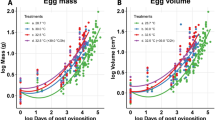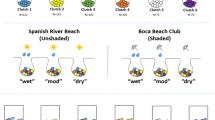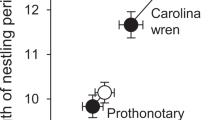Abstract
Growth of avian embryos depends on heat transferred from incubating parents. Parental behavior, including nest characteristics, can influence the length of the incubation period by varying the temperature of incubated eggs, the length of parental absences from the nest, and the rate of egg cooling during absences. Reduced parental attendance in response to risk of predation at the nest has been proposed as an explanation for the longer incubation periods of many tropical birds compared to temperate species. We incubated the eggs of eight species of tropical passerine birds, with natural incubation periods between 12 and 19 days, at the same constant temperature, thereby removing variation in incubation temperature and the cooling periods that eggs might otherwise experience when parents take recesses from incubation. If differences in egg temperature, reflecting parental behavior, were responsible for variation in incubation periods, incubation under constant conditions should reduce or eliminate this variation. Constant egg warming did not reduce time to hatch in species with long incubation periods. Instead, it prolonged embryo development in species with shorter natural periods by up to 2 days, and had no effect on species with longer natural periods. Thus, the longer incubation periods of some tropical birds appear to reflect intrinsic differences in the embryo development program rather than extrinsic factors related to parental incubation behavior.
Zusammenfassung
Konstante Bebrütung beschleunigt nicht die Embryonalentwicklung bei neotropischen Singvogelarten
Das Wachstum von Vogelembryonen hängt von der durch den brütenden Altvogel erzeugten Wärme ab. Das elterliche Verhalten inklusive der Nesteigenschaften kann die Länge der Inkubationsphase durch variierende Temperaturen der bebrüteten Eier, durch die Länge der Abwesenheitsphasen der Eltern vom Gelege sowie durch die Auskühlung der Eier während dieser Abwesenheitsphasen beeinflussen. Eine verringerte elterliche Nestbesetzung infolge des Prädationsrisikos auf dem Nest könnte eine Erklärung liefern für längere Inkubationszeiten bei vielen tropischen Vogelarten im Vergleich zu Arten der gemäßigten Zonen. Wir untersuchten die Embryonalentwicklung von acht tropischen Singvogelarten und bebrüteten deren Eier mit normalen Inkubationszeiten von 12 bis 19 Tagen bei konstanter Temperatur. Damit konnten Schwankungen der Bebrütungstemperatur und ein Auskühlen der Eier vermieden werden, was unter natürlichen Bedingungen passieren kann, wenn Altvögel die Bebrütung unterbrechen. Wenn Unterschiede in der Eiertemperatur, ausgelöst durch das elterliche Bebrütungsverhalten, verantwortlich sind für Schwankungen der Gesamtinkubationszeit, dann sollte eine Bebrütung unter konstanten Bedingungen diese Schwankungen reduzieren oder eliminieren. Bei Arten mit langen Inkubationszeiten hat eine konstante Gelegetemperatur nicht zu einem früheren Schlupf der Eier geführt. Stattdessen hat sich die Embryonalentwicklung bei Arten mit kurzen Bebrütungszeiten bis zu zwei Tage verlängert und hatte keinen Effekt bei Arten mit längeren Inkubationszeiten. Demnach scheinen bei einigen tropischen Vogelarten die längeren Inkubationszeiten eher intrinsische Unterschiede in der Embryonalentwicklung zu reflektieren, als extrinsische Faktoren im Zusammenhang mit dem elterlichen Inkubationsverhalten.
Similar content being viewed by others
References
Austin SH, Hau M, Robinson WD (2013) Effect of photoperiod on incubation period in a wild passerine, Sylvia atricapilla. J Avian Biol (in press)
Baggott GK, Deeming DC, Latter GV (2002) Electrolyte and water balance of the early avian embryo: effects of egg turning. Avian Poult Biol Rev 13:105–119
Brawn J, Angehr G, Davros N, Robinson WD, Styrsky JN, Tarwater C (2011) Sources of variation in the nesting success of understory tropical birds. J Avian Biol 42:61–68
Chalfoun AD, Martin TE (2007) Latitudinal variation in avian incubation attentiveness and a test of the food limitation hypothesis. Anim Behav 73:579–585
Cooper CB, Voss MA, Ardia DR, Austin SH, Robinson WD (2011) Light increases the rate of embryonic development: implications for latitudinal trends in incubation period. Funct Ecol 25:769–776
Deeming DC (2002) Avian incubation: behaviour, environment, and evolution. Oxford University Press, Oxford
Drent RH (1970) Functional aspects of incubation in the Herring Gull. Behaviour 17:1–132
Kern MD, Cowie RJ (1995) Humidity levels in Pied Flycatcher nests measured using capsule hygrometers. Auk 112:564–570
Kern MD, Cowie RJ (2000) Female pied flycatchers fail to respond to variations in nest humidity. Comp Biochem Physiol Part A 127:113–119
Kuehler C, Good J (1990) Artificial incubation of bird eggs at the Zoological Society of San Diego. Int Zoo Yearb 29:118–136
Landauer W (1967) The hatchability of chicken eggs an influenced by environment and heredity monographs of the Storrs agricultural experiment station. University of Connecticut, Connecticut
Lundy H (1969) A review of the effects of temperature, humidity, turning and gaseous environment in the incubator on the hatchability off the hen’s egg. In: Carter TC, Freeman BH (eds) The fertility and hatchability of the Hen’s egg. Oliver and Boyd, Edinburgh, pp 143–176
Martin TE (2002) A new view of avian life-history evolution tested on an incubation paradox. Proc R Soc Lond B 269:309–316
Martin TE, Schwabl H (2008) Variation in maternal effects and embryonic development rates among passerine species. Philos Trans R Soc Lond B 363:1663–1674
Martin T, Auer SK, Bassar RD, Niklison AM, Lloyd P (2007) Geographic variation in avian incubation periods and parental influences on embryonic temperature. Evolution 61:2558–2569
Martin TE, Ton R, Niklison A (2013) Intrinsic vs. extrinsic influences on life history expression: metabolism and parentally induced temperature influences on embryo development rate. Ecol Lett 16:738–745
Olsen GH, Club SL (1997) Embryology, incubation and hatching. In: Altman SLCRB, Dorrestein GM, Quesenberry K (eds) Avian medicine and surgery. W. B. Saunders Company, New York, pp 54–71
Rahn H, Ackerman RA, Paganelli CV (1977) Humidity in the avian nest and egg water loss during incubation. Physiol Zool 50:269–283
Ricklefs RE (1969) The nesting cycle of songbirds in tropical and temperative regions. Living Bird 8:165–175
Ricklefs RE (1977) Reactions of some Panamanian birds to human intrusion at the nest. Condor 79:376–379
Ricklefs RE (1992) Embryonic development period and the prevalence of avian blood parasites. Proc Natl Acad Sci USA 89:4722–4725
Ricklefs RE (1993) Sibling competition, hatching asynchrony, incubation period, and lifespan in altricial birds. Curr Ornithol 11:199–276
Ricklefs RE, Brawn JD (2013) Nest attentiveness in several Neotropical suboscine passerine birds with long incubation periods. J Ornithol 154:145–154
Robinson WD, Brawn JD, Robinson SK (2000a) Forest bird community structure in central Panama: influence of spatial scale and biogeography. Ecol Monogr 70:209–235
Robinson WD, Robinson TR, Robinson SK, Brawn JD (2000b) Nesting success of understory forest birds in central Panama. J Avian Biol 31:151–164
Robinson WD, Styrsky JD, Payne BJ, Harper RG, Thompson CF (2008) Why are incubation periods longer in the tropics? A common-garden experiment with house wrens reveals it is all in the egg. Am Nat 171:532–535
Romanoff AL (1929) Effect of humidity on the growth, calcium metabolism, and mortality of the chick embryo. J Exp Zool 54:343–348
Romanoff AL (1930) Biochemistry and biophysics of the development of hen’s egg. Mem Cornell Univ Agric Exp Stn 132:1–27
Rompré GR, Robinson WD (2008) Predation, nest attendance, and long incubation periods of two Neotropical antbirds. Ecotropica 14:81–87
Shutze JV, Lauber JK, Kato M, Wilson WO (1962) Influence of incandescent and colored light on chicken embryos during incubation. Nature 196:594–595
Tieleman BI, Williams JB, Ricklefs RE (2004) Nest attentiveness and egg temperature do not explain the variation in incubation periods in tropical birds. Funct Ecol 18:571–577
Wetherbee D, Wetherbee N (1961) Artificial incubation of eggs of various bird species and some attributes of neonates. Bird Banding 32:141–159
Wiersma P, Munoz-Garcia A, Walker A, Williams JB (2007) Tropical birds have a slow pace of life. Proc Natl Acad Sci USA 104:9340–9345
Wikelski M, Hau E, Robinson WD, Wingfield JC (2003) Reproductive seasonality of seven Neotropical passerine species. Condor 105:683–695
Acknowledgments
For their help in the field, we thank Lisa Miller, David Bradley, Ruby Zambrano, Betzi Perez, BriAnne Addison, and Rebecca Gamboa. We were supported by NSF (IBN-0212587). Smithsonian Tropical Research Institute provided logistical support. Egg handling was approved by Oregon State University Animal Care Protocol 3212 and permitted by Republic of Panama Autoridad Nacional del Ambiente (ANAM).
Author information
Authors and Affiliations
Corresponding author
Additional information
Communicated by L. Fusani.
Rights and permissions
About this article
Cite this article
Robinson, W.D., Austin, S.H., Robinson, T.R. et al. Incubation temperature does not explain variation in the embryo development periods in a sample of Neotropical passerine birds. J Ornithol 155, 45–51 (2014). https://doi.org/10.1007/s10336-013-0985-9
Received:
Revised:
Accepted:
Published:
Issue Date:
DOI: https://doi.org/10.1007/s10336-013-0985-9




